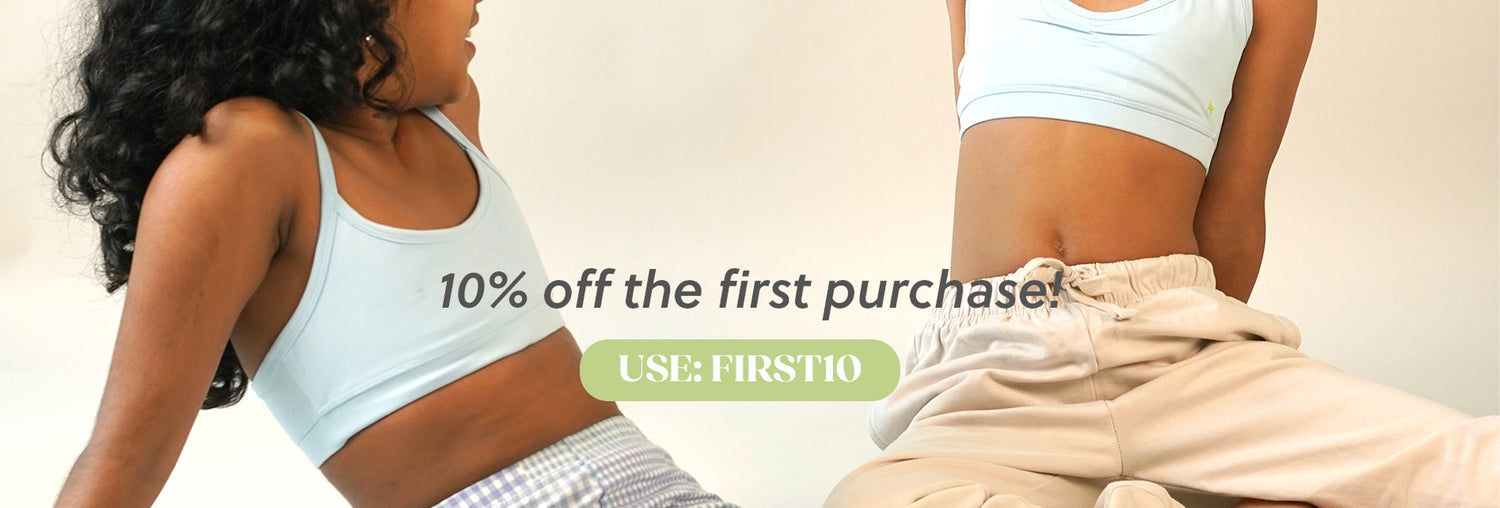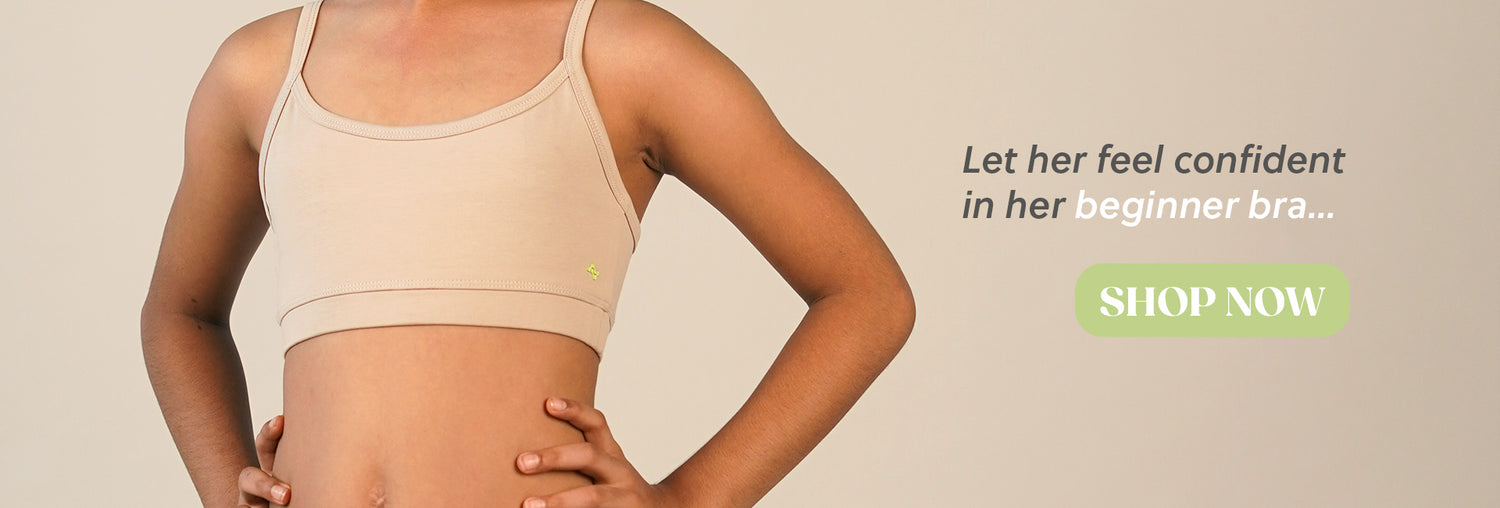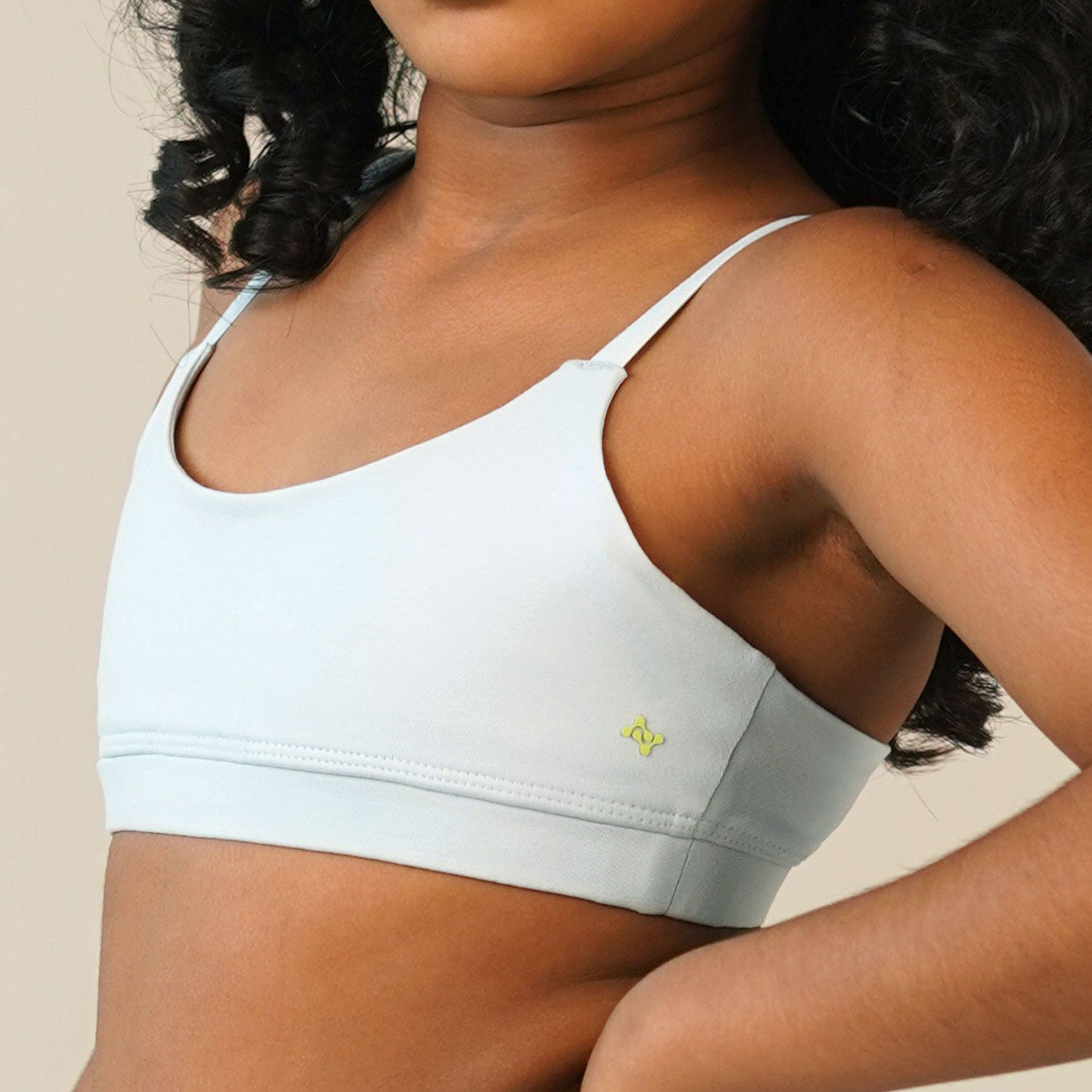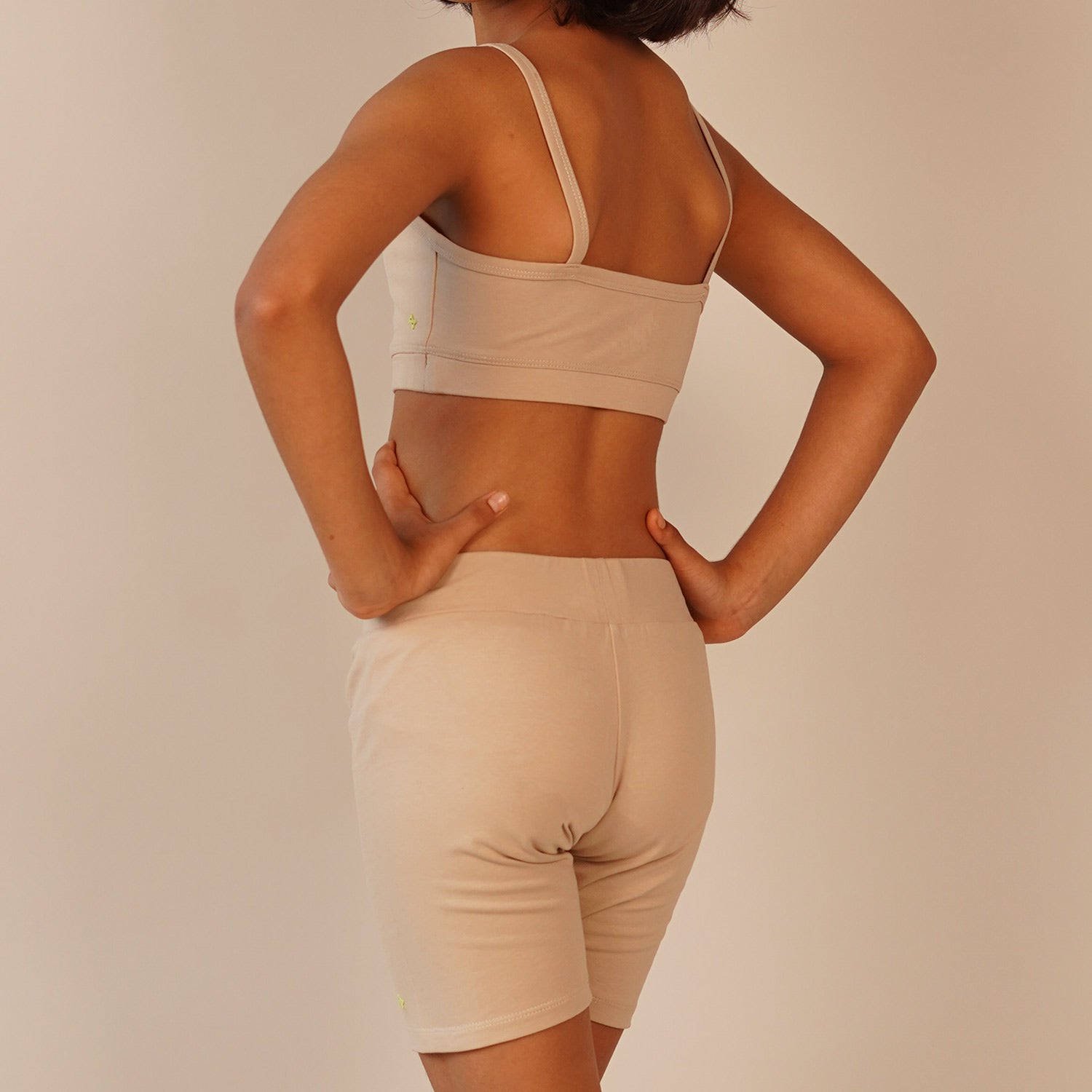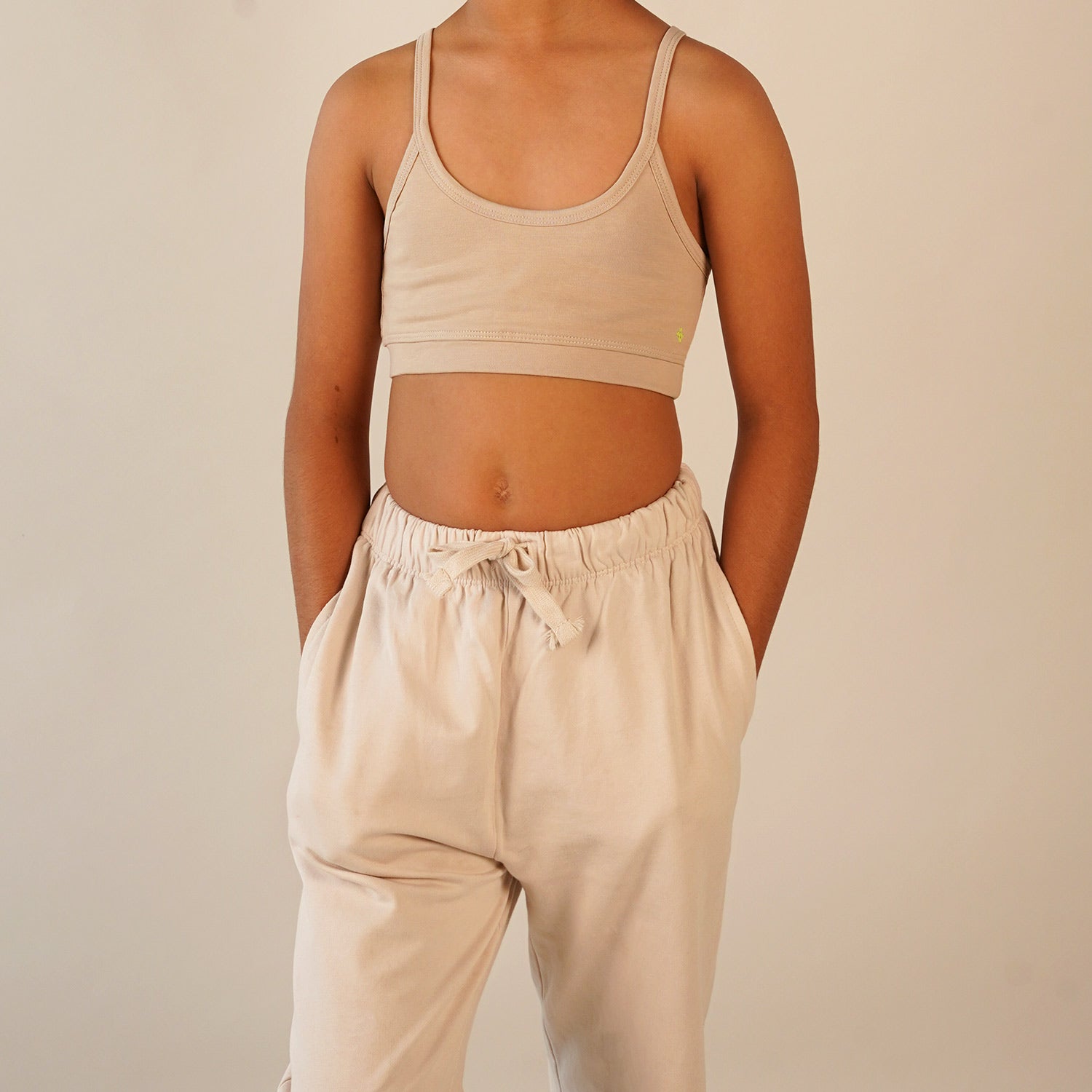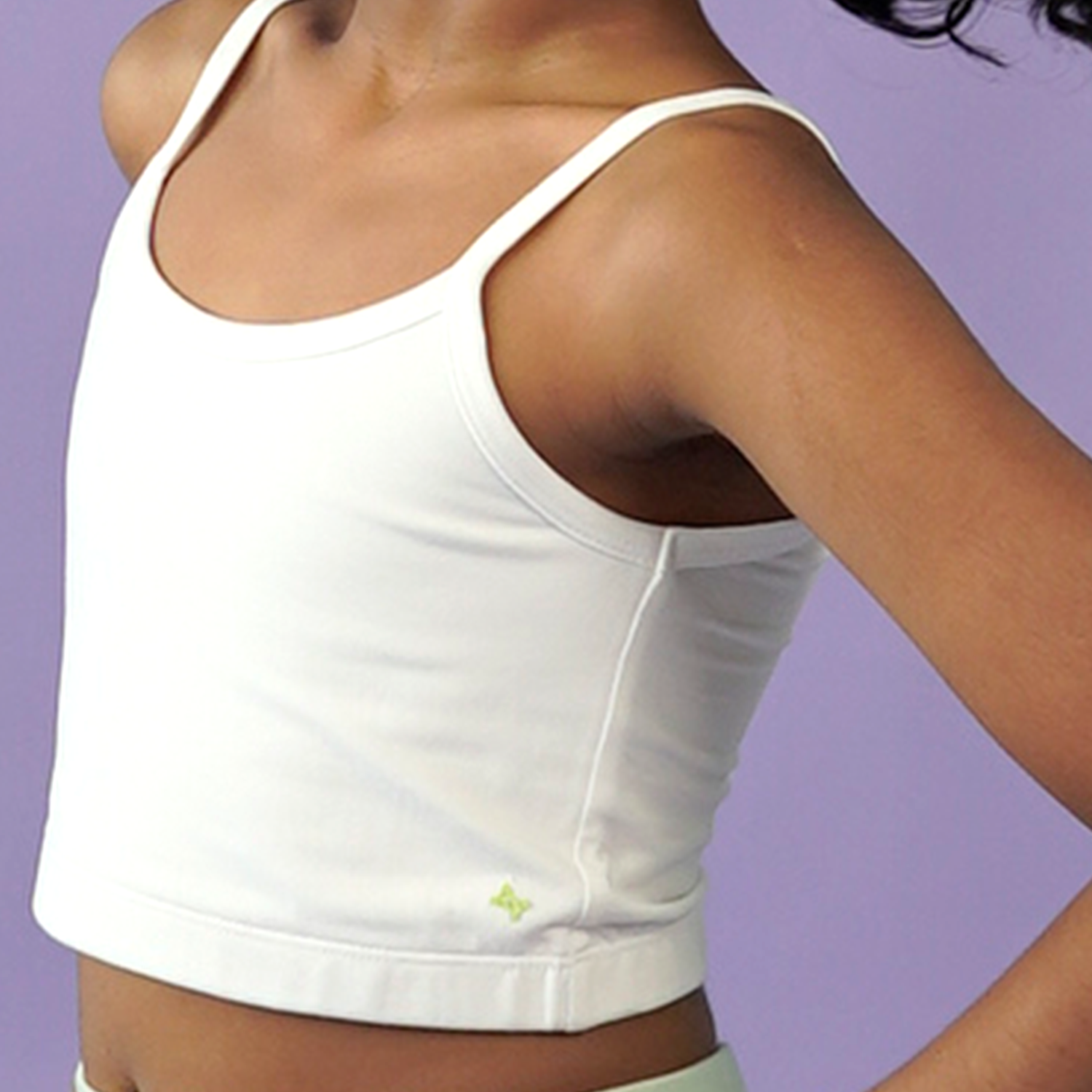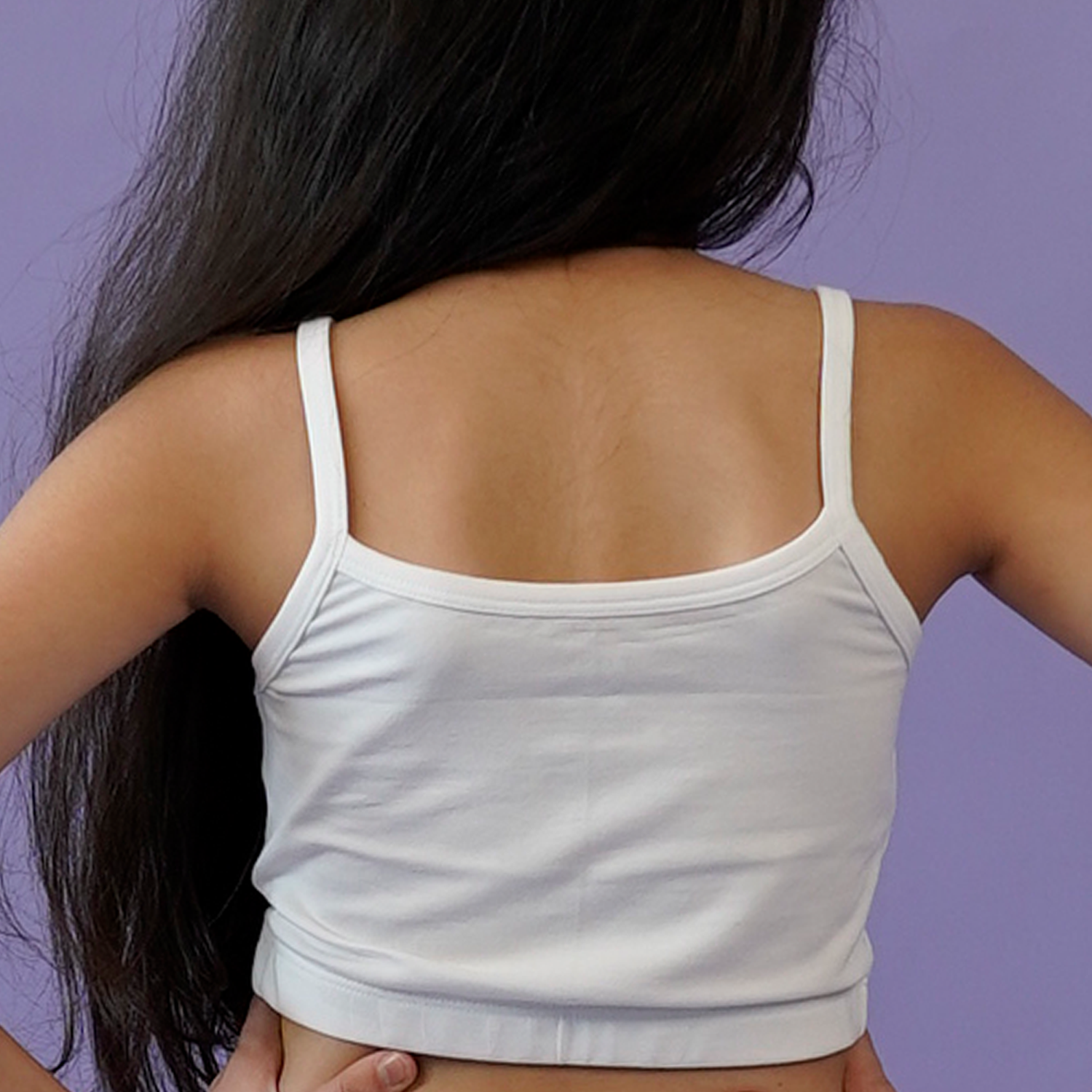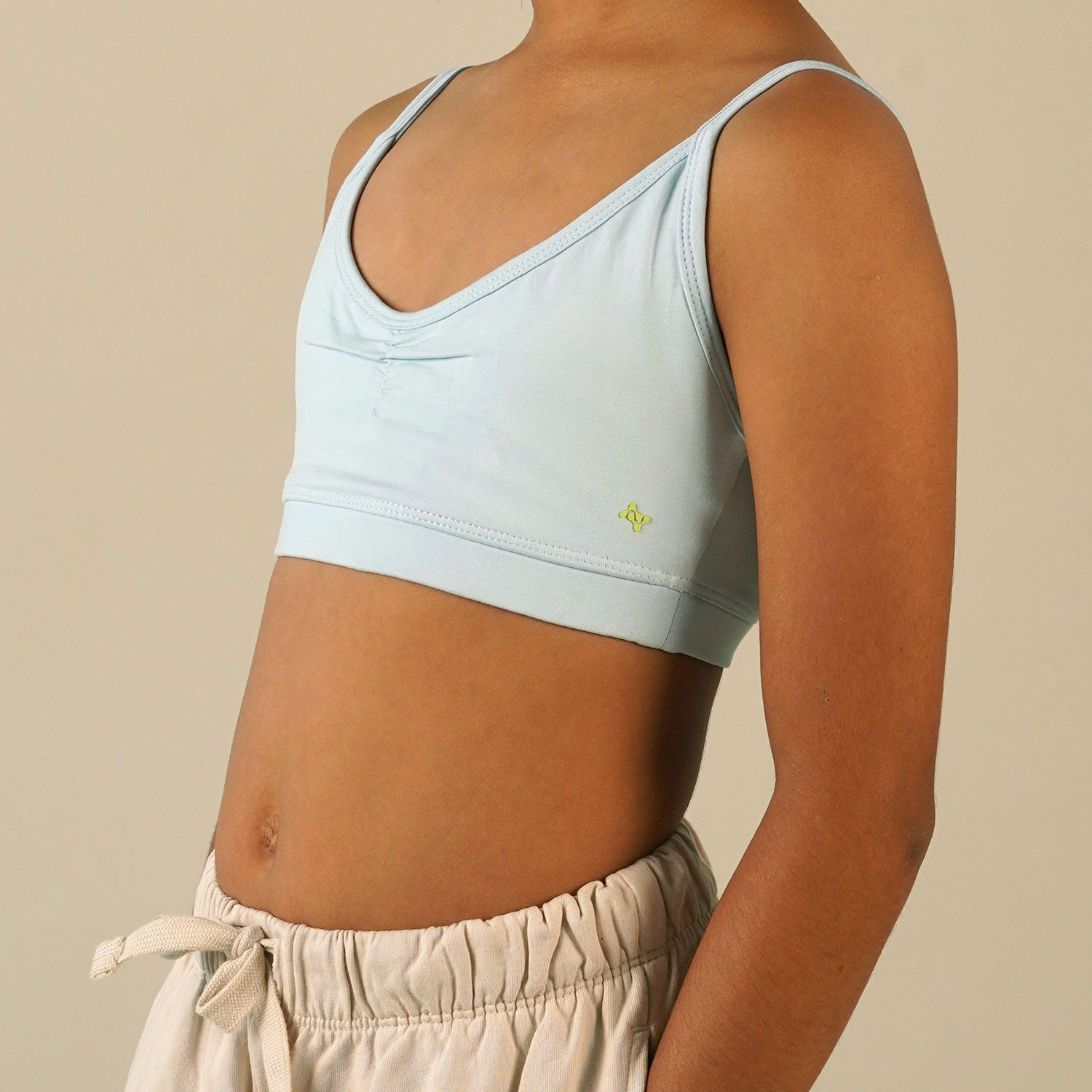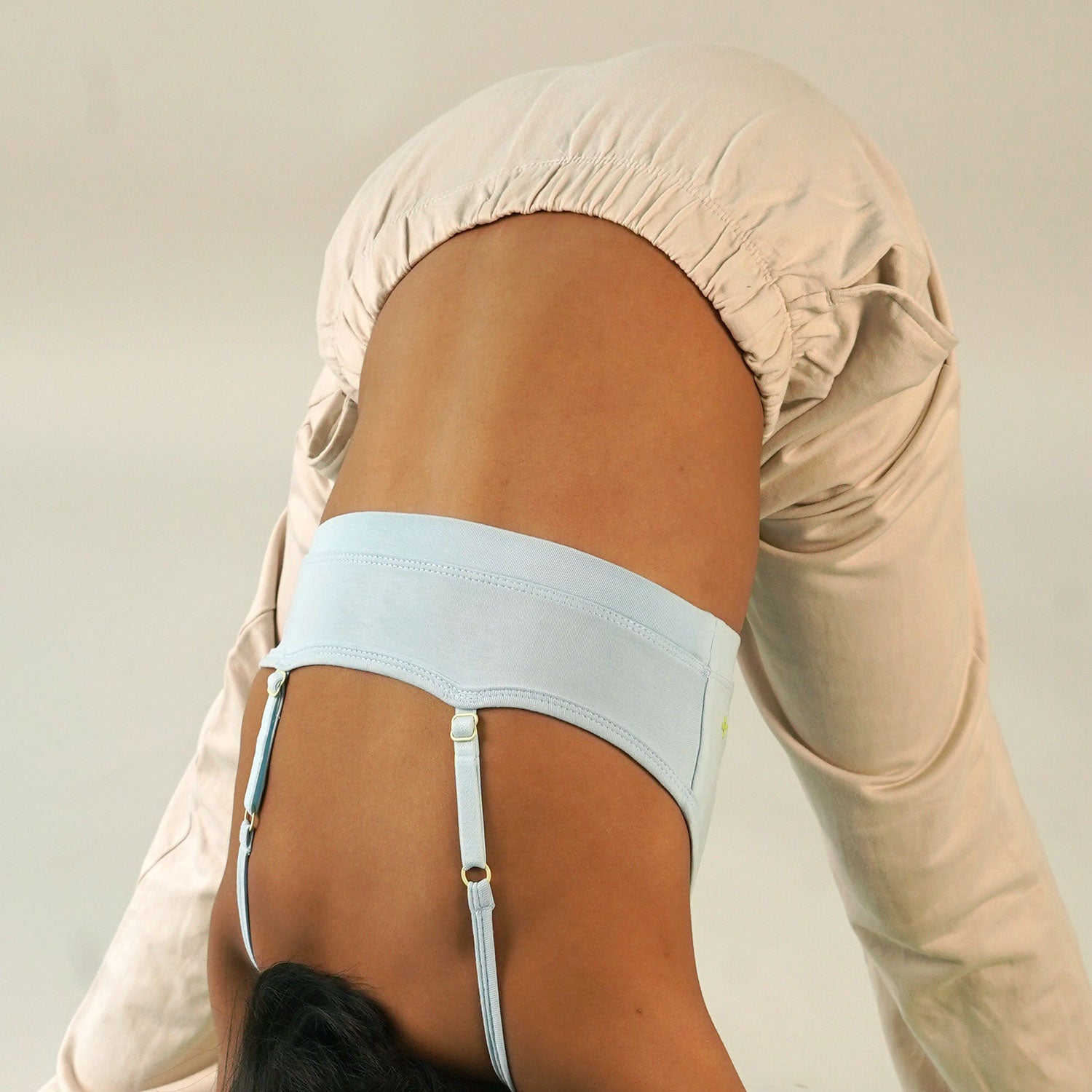Designed for growing bodies
Thoughtfully made innerwear that support comfort, confidence, and body awareness.

Our NEW School Bundle is now live!
The perfect inner-layer to go under uniforms for pre-teens and teens...
Growing Up, Together
How to Know Her Size Without Making It Awkward
How to Know Her Size Without Making It Awkward The Unspoken Challenge If you’ve ever found yourself holding a tape measure and second-guessing “Will she feel weird if I ask to measure?”, you’re not alone.Finding your daughter’s first bra size can feel awkward, but it doesn’t have to be. With the right words, timing, and approach, it can be a moment of bonding, not embarrassment. Why Getting the Right Size Matters Wrong fits affect posture and comfort.A too-tight band can restrict breathing; a loose one can cause rubbing and shoulder strain. The wrong cup shape affects confidence.When the cup gaps or presses, she becomes aware of her body often in ways that trigger self-consciousness. Right fit = right message.You’re telling her, “Your body deserves comfort and care,” not “your body needs hiding.” The way you introduce her first bra teaches her how to treat her body with comfort or with shame. Step-by-Step: How to Measure Her, Gently 1. Pick the Right Moment After bath or bedtime, when she’s calm and comfortable. You can even say, “We’re just finding what fits you best like when we try new shoes.” 2. Explain Why, Before How Frame it as support, not scrutiny: “Every girl’s body grows differently, we just want yours to feel comfy.” 3. Use the 2-Step Method Band size: Measure around the chest, just under the bust, snug but not tight. Round to the nearest even number. Cup coverage: Measure around the fullest part of the chest. Subtract the first number the difference tells you her cup type (1 inch = A1, 2 inch = A2, etc.). 4. Involve Her in the Process Let her hold the tape, look in the mirror, and note her own number. It builds body awareness and ownership. 5. Normalize Size Changes Remind her that growth means change. “If your size changes next month, it just means your body is doing exactly what it’s supposed to.” Apoio’s Promise: Size That Grows With Her Apoio’s fit system is designed to accommodate natural growth patterns and various frames without pressure.Our bras use flexible, that adapt to subtle size changes so moms don’t have to constantly re-measure. Simple Start Training Bra — for first-time wearers Cover Lite Petite — for narrow shoulders and developing curves SoftSquare Boyshorts — for confident movement and full coverage Making It a Memory, Not a Moment Her first bra fitting can be more than functional, it can be foundational.When handled with warmth, it becomes a story she remembers with pride: ✨ Find her perfect fit with our Apoio Size Guide and explore the Simple Start collection, designed to fit like a hug, not a reminder.
Read moreWhy Preteen Skin Is Different and What to Do About It
Why Preteen Skin Is Different and What to Do About It Understanding Her Skin Through Change Puberty doesn’t just bring growth spurts and mood swings, it also changes your daughter’s skin in ways you may not expect. Around ages 9–13, the body’s hormonal shifts affect everything from oil glands to sweat patterns, making the skin more sensitive and reactive. At Apoio, we design from empathy, not assumptions. And that means understanding how comfort, fabric, and breathability play a huge role in supporting a girl’s developing skin.especially when it comes to teens innerwear like training bras and starter bras. What Makes Preteen Skin Unique? 1. Hormonal Oil Production Begins As estrogen and androgens increase, so does sebum (oil) production. This can lead to clogged pores, especially in areas where fabric sits close to the body like the underarms, chest, and waistband zones. Dermatologists note that excess sebum combined with friction can cause mild irritation or folliculitis (tiny bumps). (Cleveland Clinic, 2023) 2. Higher Sweat Sensitivity Sweat glands activate earlier in puberty. When tight or synthetic clothing traps moisture, it creates a warm, humid environment perfect for bacterial growth, leading to rashes or itchiness. Cotton is proven to be the most breathable and hypoallergenic natural fiber, reducing irritation by allowing airflow. (NIH Textile Research, 2022) That’s why good bras for teens and training bras for girls made with soft, breathable cotton make a huge difference in daily comfort. 3. Developing Skin Barrier Young skin is thinner and loses moisture faster than adult skin. Fabrics with elastic fibers, when not soft-lined, can cause micro-abrasions, especially under straps or waistbands. Dermatologists recommend “smooth, non-abrasive materials” to prevent chafing and barrier damage. (American Academy of Dermatology, 2022)Choosing the best training bras for 9 year olds means focusing on comfort and protection, not pressure. Everyday Habits That Help Opt for breathable cotton, it regulates temperature and prevents bacterial buildup. Avoid layering synthetics like nylon or polyester for long hours. Encourage daily fresh change of innerwear, even on non-active days. Moisturize after bathing to restore the skin barrier. Use fragrance-free detergent for innerwear to avoid skin sensitization. “Comfort isn’t just how fabric feels, it’s how skin breathes through it.” How Apoio Cares for Her Skin Every Apoio piece is designed to honour the body’s transitions starting with the skin. Our Simple Start bras are crafted from ultra-soft, breathable cotton blends with no harsh elastics. Gentle Day underwear uses picot edging and double-lined gusset to avoid friction on developing skin. All labels are heat-sealed, not stitched, because irritation should never come from inside. A Gentle Reminder Preteen skin isn’t “problem skin”, it’s developing skin.The best thing you can do is keep it clean, dry, and loved just like she needs your love as she grows. ✨ Explore comfort that cares with Apoio’s Simple Start and Gentle Day collections.
Read moreRaising Body-Positive Daughters in a Filtered World
Raising Body-Positive Daughters in a Filtered World A Note from Apoio In today’s world, mirrors don’t just hang on walls; they live in our phones. Between filters, edits, and endless scrolling, young girls are growing up comparing themselves to pictures that aren’t even real.At Apoio, we believe every girl deserves to feel comfortable, confident, and seen for who she truly is. This isn’t just about teens innerwear, it’s about inner strength. The Pressure to Look Perfect A global study of more than 21,000 adolescents (ages 10–17) found that over 55% of girls are dissatisfied with their bodies, and the more time they spend online, the higher that dissatisfaction becomes (University of Waterloo, 2023). In another report by the Mental Health Foundation (UK), 54% of girls said that social media images made them worry about their bodies. The constant comparison, likes, and comments can quietly shape how a young girl sees herself before she even knows who she is becoming. “Our daughters are growing up in a world where perfection feels like a filter away. Let’s help them see beauty beyond the screen.” Why This Matters, Especially Now The early teen years (10–13) are when girls’ self-esteem and body image begin to form. Researchers note that adolescence is the most sensitive phase for body confidence, as physical changes, hormonal shifts, and identity-building collide (BMC Women’s Health, 2022). When a girl starts to notice her body changing whether that’s developing curves or acne, she often looks outward for answers. Social media, peers, and advertising quickly become mirrors of validation or judgment. This is why the voice of a parent, teacher, or mentor becomes essential: it can be the quiet counterweight to all that noise. The Role of Innerwear in Confidence While body image often feels like a “big topic,” sometimes it starts with the smallest things, like what she wears underneath. Comfort builds confidence: When a training bra feels soft, weightless, and secure, she’s not distracted by her body, she’s empowered by it. Fit sends a message: The right fit says, “Your body is growing, and that’s perfectly normal.” The wrong one says, “Something needs fixing.” Narrative matters: When innerwear is spoken about as “covering up,” it can feel like shame. When it’s introduced as “supporting your growth,” it becomes pride. That’s why every Apoio design from the Simple Start training bra to Cover Lite is made to “melt onto her body”, letting her move freely, feel supported, and grow confidently. Five Gentle Ways to Raise Body-Positive Daughters 1. Start Early, Keep It Natural Don’t wait for “the talk.” Instead, create an ongoing, easy conversation about body changes.Try: “You’re growing beautifully,” or “Your body is becoming stronger, how amazing is that?” 2. Teach Media Literacy Show her how filters, editing, and algorithms work. Discuss why influencers always look “perfect.”Encourage her to follow accounts that make her feel good and not less than. 3. Focus on What the Body Can Do Shift the attention from “how it looks” to “what it does.”“You climbed that wall today, your legs are powerful!” or “Your arms are strong from dance practice.” 4. Involve Her in Her Choices Let her pick her first training bra or innerwear. When she gets to choose, she learns agency and self-expression, not embarrassment. 5. Model Positive Behaviour Yourself Your daughter watches how you speak about your own body. Replace “I feel fat today” with “I feel tired, I need rest.”When you celebrate your body, she learns to celebrate hers. “The way we speak about our bodies becomes her inner voice.” A Small Step with Big Meaning Buying her first training bra may seem like a tiny moment, but it’s often her first experience of body awareness, comfort, and pride. When she learns to feel good in her body, she also learns to feel enough in herself. That’s why we at Apoio design the best training bras for 9 year olds and teens innerwear not to hide, but to honour her growth, because comfort is confidence in its truest form. Sources: University of Waterloo. Negative Body Image Among Teens Is a Global Issue (2023) Mental Health Foundation. Body Image Report — Executive Summary: Childhood (2021) BMC Women’s Health. Adolescent Girls’ Experiences of Body Image and Social Media (2022) Harvard School of Public Health. Exploring the Effect of Social Media on Teen Girls’ Mental Health (2023)
Read more
Get To Know Us More...
At Apoio, we understand that no two children are the same. Every developing body deserves innerwear designed to nurture, not restrict. That’s why we are here, to be the brand that truly understands the delicate transition into adolescence, making it smoother, more comfortable, and completely worry-free for both moms and kids.


